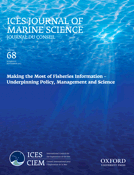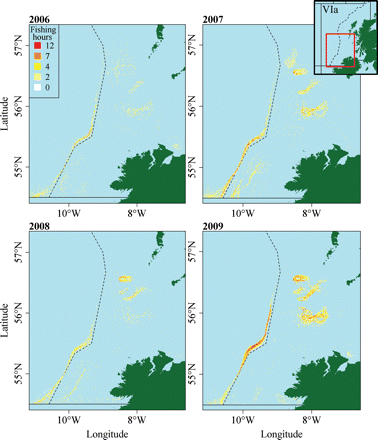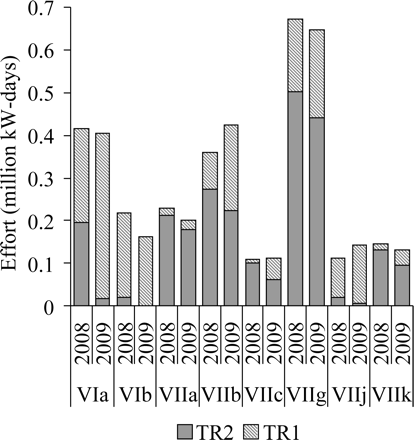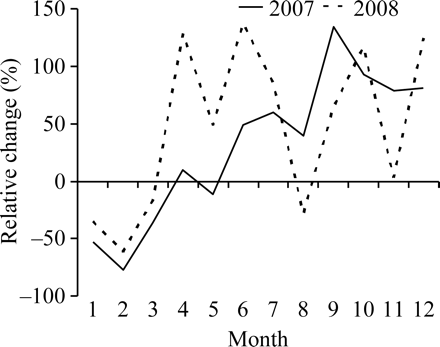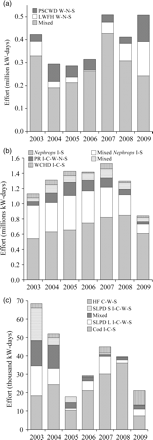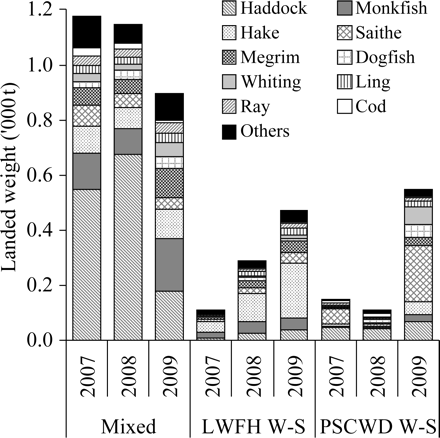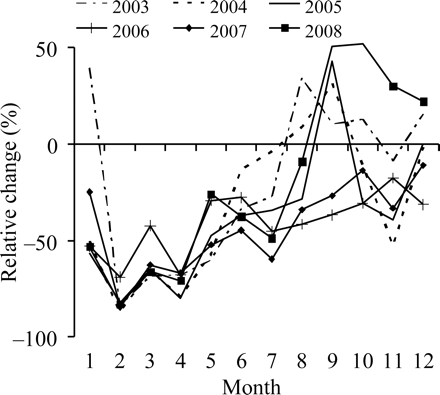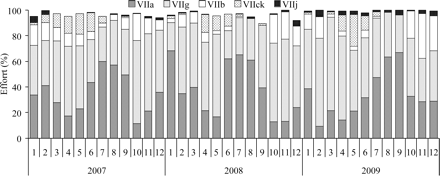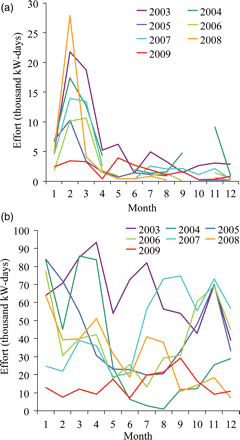-
PDF
- Split View
-
Views
-
Cite
Cite
Sarah Davie, Colm Lordan, Examining changes in Irish fishing practices in response to the cod long-term plan, ICES Journal of Marine Science, Volume 68, Issue 8, September 2011, Pages 1638–1646, https://doi.org/10.1093/icesjms/fsr052
Close - Share Icon Share
Abstract
In 2009, there were marked changes in Irish demersal fishing effort owing to the implementation of a new cod long-term plan (CLTP). This replaced previous top-down cod recovery plans, first implemented in 2002, that set days-at-sea limits for fishing vessels. The new plan specifies a harvest control rule, annual effort ceilings for EU Member States, and rules for adapting fishing effort. It encourages cod avoidance, but leaves Member States to allocate effort between individual vessels. During 2009, effort was allocated through a series of pilot schemes in Ireland. These can be considered as an evolution towards co-management. Industry and state authorities worked closely together to develop strategies for effort management and cod avoidance. The impact of recent effort-management measures on the Irish fleet, fishery, and métiers affected by the CLTP is evaluated. Vessel movements within and between métiers are described and discussed, and unintended impacts resulting from the implementation of management schemes are highlighted. In future, possible fishers' responses to policy initiatives should be considered prior to implementation to minimize potentially adverse consequences.Davie, S., and Lordan, C. 2011. Examining changes in Irish fishing practices in response to the cod long-term plan. – ICES Journal of Marine Science, 68: 1638–1646.
Introduction
The fishing pressure exerted on cod stocks in European waters has long been considered to be unsustainable. As a result, several stocks have declined to dangerously low levels. In an effort to reduce fishing mortality, the European Union (EU) has adopted various management initiatives in the Irish Sea (ICES Division VIIa), west of Scotland (VIa), and North Sea (IV).
Under the Common Fisheries Policy, total allowable catches (TACs) were established and progressively reduced, yet stocks continued to decline. In 2003, effort management was introduced in conjunction with TACs encompassing the west of Scotland (EC, 2002) and further expanded in 2004 to include the Irish Sea (EC, 2003). This top-down scheme specified the number of days individual vessels were permitted to be at sea, varying with area and gear configuration, with the aim of reducing fishing mortality (EC, 2004). In many cases, the sea-day allowance decreased annually, particularly for gear configurations traditionally used to target whitefish, such as bottom otter trawls with codend mesh sizes of 100 mm or more. Despite these measures, there was little evidence of commensurate reduction in fishing mortality, according to ICES stock assessment (ICES, 2010).
In 2008, the EU Fisheries Council adopted a cod long-term plan (CLTP; EC, 2008). The plan aims to recover stocks and achieve sustainable exploitation at a target fishing mortality (0.4) corresponding to the maximum sustainable yield, by managing demersal fishing pressures within several areas. This was implemented in February 2009 (EC, 2009). The CLTP contains harvest- and effort-control rules, implementation rules, and potential derogations to encourage the development of cod-avoidance measures. It specifies effort ceilings for EU Member States, developed using historical international fishery-dependent data. The effort is defined as the vessel engine power (kW) multiplied by the days spent at sea, summed over the fleet, giving kW-days as the unit. The ceilings are partitioned into fishing gear groups for each area covered by the plan. Member States decide individually how effort is to be allocated to their fishers. The ceilings become increasingly restrictive over time for types of cod-catching gear until recovery is achieved. The five gear groups covered by the CLTP are described in the relevant Council Regulation (EC, 2009) as follows: Irish fishers primarily use bottom otter trawls, and to a lesser extent beam trawls, gillnets, and demersal seines, to target various demersal fisheries. Combined, these gears account for ∼70% of all Irish fishing effort, the remainder being primarily split between pelagic, potting, and dredging gears. Large-mesh beam trawls, trammelnets, and longlines are rarely used by Irish vessels. The Irish Sea and west of Scotland areas fall under the CLTP effort restrictions and are important fishing grounds for the Irish demersal fleet.
bottom trawls, Danish seines, and similar towed gear (excluding beam trawls) of codend mesh size ≥100 mm (TR1), ≥70 mm and <100 mm (TR2), and ≥16 mm and <32 mm (TR3);
beam trawls of mesh size ≥120 mm (BT1), and ≥80 mm and <120 mm (BT2);
gillnets and entangling nets (excluding trammelnets; GN1);
trammelnets (GT1);
longlines (LL1).
In 2009, Ireland endeavoured to follow the spirit of the regulation by taking actions to reduce cod mortality by 25% or more. The Irish administration actively encouraged vessels to adopt fishing practices that would avoid cod catches. To the west of Scotland, this included fishers avoiding grounds where cod aggregations were known. For example, ICES rectangle 39E3 was voluntarily avoided by Irish fishers in 2009, with subsequent closures under national regulation, 1 February to 31 March 2010, and 1 October 2010 until 31 January 2011. Gear trials were carried out in the Irish Sea incorporating separator panels and grids in otter trawls to improve selectivity. The most active fishery in the Irish Sea (for Nephrops) was subsequently given incentives of additional effort to employ these devices.
Several pilot allocation schemes were implemented to divide effort between individual vessels, primarily based on recent track records. The state-retained control and private transfers of effort allocations between vessels were not allowed. The first scheme, from 1 February to 30 April 2009, was the most restrictive. Conservative allocations were assigned to ensure that adequate effort remained for later in the year, allowing vessels to re-enter the fleet. Two subsequent schemes, 1 May–31 October 2009 and 1 November 2009–31 January 2010, were adaptations based on the experiences and effort uptake from the previous period. These were less restrictive, and unused effort from the previous period was redistributed, in most cases giving fishers additional effort allocations as time progressed. The schemes and avoidance measures were developed by policy-makers and control authorities, in close consultation with industry and supported by scientific analysis of fishery-dependent data.
Here, we explore the impact of this latest form of effort management, by examining the changes to the Irish fleet, fishery, and métiers affected by the CLTP (a métier is a group of fishing trips carried out by similar vessels within a fishery; ICES, 2003). Vessel movements within and between métiers are described and discussed. The results focus on CLTP areas where Irish demersal fishers are most active, namely west of Scotland and in the Irish Sea. Identifiable changes outside the CLTP remit, which are believed to have occurred as a consequence of its implementation, are highlighted.
Methods
The investigation is based on the examination of fishery-dependent data from Irish logbooks and vessel monitoring systems (VMSs). The logbook data, from the Integrated Fisheries Information System (IFIS) database, was provided by the Irish Department of Agriculture, Fisheries and Food. The information encompasses all fishing trips by Irish vessels ≥10 m from 2003 to 2009. Irish VMS data from 2005 to 2009 were provided by the Irish Naval Services (FMC).
Irish métiers were determined prior to this investigation by statistically segmenting fishing trips into homogeneous groupings based on species-composition profiles, seasons (using month as a proxy), fishing areas, and vessel characteristics, including gear type, mesh size range, and vessel length. Details of a similar methodology are provided in Davie and Lordan (2009).
Logbook and VMS data were integrated using the methodology described in Gerritsen and Lordan (2011). A simple speed rule was applied to identify the majority of fishing operations relating to trawl gear, where speeds between 1.5 and 4.5 knots are considered to be fishing activity. VMS positions relating to fishing activity were then integrated with catch-and-effort data from logbooks via a vessel identifier and the date. Integrated logbook and VMS data allow analysis of fisheries-dependent data on a fine spatial scale.
Data manipulation and analysis were carried out using the software Microsoft SQL Server 2008 Management Studio software and the R language and environment for statistical computing (R Development Core Team, 2008).
Results
Within the west of Scotland (VIa) and Irish Sea (VIIa) areas, regulated effort generally declined in 2009, and most ceilings were not reached (Table 1). TR1 to the west of Scotland is the only exception, showing an increase of ∼25%, exceeding the 2009 allocation by >60%. However, Ireland was permitted to transfer effort between gear categories (EC, 2008), and effort was transferred from the primarily unused TR2 category to TR1, adjusting the effort ceilings.
The west of Scotland (VIa) and Irish Sea (VIIa) kW-days for the CLTP gear categories effort groups, as defined in the text; Council Regulation No.1342/2008, 2003–2009, with details of 2009 effort ceilings allocated to Ireland (EC, 2009), uptake from January to December 2009 (%), and the 2008 effort by subsequently decommissioned vessels (removed, %).
| Area . | Effort group . | 2003 . | 2004 . | 2005 . | 2006 . | 2007 . | 2008 . | 2009 . | Effort ceiling (kW) . | Uptake (%) . | Removed (%) . |
|---|---|---|---|---|---|---|---|---|---|---|---|
| West of Scotland | TR1 | 496 438 | 316 478 | 308 680 | 323 880 | 530 291 | 435 213 | 549 302 | 310 005 | 163 | 0 |
| TR2 | 1 039 254 | 967 586 | 767 637 | 712 743 | 384 398 | 196 959 | 17 989 | 481 938 | 3 | 0.2 | |
| TR3 | 2 198 | 342 | 160 | 317 | 11 321 | 1 323 | 21 327 | 0 | 0 | ||
| BT2 | 0 | 28 827 | 5 068 | 6 335 | 0 | 0 | 0 | 3 914 | 0 | 0 | |
| GN1 | 19 967 | 20 763 | 192 | 3 554 | 13 348 | 9 949 | 3 276 | 6 400 | 44 | 0 | |
| GT1 | 0 | 0 | 5 410 | 449 | 0 | 0 | 0 | 1 946 | 0 | 0 | |
| LL1 | 7 200 | 18 400 | 3 000 | 0 | 9 750 | 0 | 0 | 1 013 | 0 | 0 | |
| Total | 1 565 057 | 1 352 054 | 1 090 329 | 1 047 121 | 938 104 | 653 442 | 571 890 | 826 543 | 63 | 0.1 | |
| Irish Sea | TR1 | 358 717 | 134 382 | 87 264 | 84 551 | 140 395 | 73 005 | 60 348 | 79 246 | 70 | 23 |
| TR2 | 1 194 559 | 1 345 089 | 1 464 650 | 1 458 922 | 1 582 409 | 1 311 141 | 853 165 | 1 120 977 | 69 | 28 | |
| TR3 | 900 | 90 | 3 305 | 960 | 436 | 9 646 | 0 | 0 | |||
| BT2 | 783 381 | 411 353 | 511 814 | 481 404 | 550 534 | 374 493 | 173 927 | 507 923 | 32 | 66 | |
| GN1 | 76 613 | 60 551 | 26 671 | 29 533 | 45 084 | 40 958 | 22 213 | 24 713 | 80 | 13 | |
| GT1 | 0 | 0 | 0 | 0 | 0 | 1 327 | 1 237 | 0 | NA | 0 | |
| LL1 | 0 | 800 | 0 | 0 | 0 | 149 | 0 | 62 | 0 | 0 | |
| Total | 2 946 207 | 2 775 422 | 2 503 899 | 2 401 100 | 2 754 585 | 2 196 165 | 1 533 442 | 1 742 567 | 58 | 36 |
| Area . | Effort group . | 2003 . | 2004 . | 2005 . | 2006 . | 2007 . | 2008 . | 2009 . | Effort ceiling (kW) . | Uptake (%) . | Removed (%) . |
|---|---|---|---|---|---|---|---|---|---|---|---|
| West of Scotland | TR1 | 496 438 | 316 478 | 308 680 | 323 880 | 530 291 | 435 213 | 549 302 | 310 005 | 163 | 0 |
| TR2 | 1 039 254 | 967 586 | 767 637 | 712 743 | 384 398 | 196 959 | 17 989 | 481 938 | 3 | 0.2 | |
| TR3 | 2 198 | 342 | 160 | 317 | 11 321 | 1 323 | 21 327 | 0 | 0 | ||
| BT2 | 0 | 28 827 | 5 068 | 6 335 | 0 | 0 | 0 | 3 914 | 0 | 0 | |
| GN1 | 19 967 | 20 763 | 192 | 3 554 | 13 348 | 9 949 | 3 276 | 6 400 | 44 | 0 | |
| GT1 | 0 | 0 | 5 410 | 449 | 0 | 0 | 0 | 1 946 | 0 | 0 | |
| LL1 | 7 200 | 18 400 | 3 000 | 0 | 9 750 | 0 | 0 | 1 013 | 0 | 0 | |
| Total | 1 565 057 | 1 352 054 | 1 090 329 | 1 047 121 | 938 104 | 653 442 | 571 890 | 826 543 | 63 | 0.1 | |
| Irish Sea | TR1 | 358 717 | 134 382 | 87 264 | 84 551 | 140 395 | 73 005 | 60 348 | 79 246 | 70 | 23 |
| TR2 | 1 194 559 | 1 345 089 | 1 464 650 | 1 458 922 | 1 582 409 | 1 311 141 | 853 165 | 1 120 977 | 69 | 28 | |
| TR3 | 900 | 90 | 3 305 | 960 | 436 | 9 646 | 0 | 0 | |||
| BT2 | 783 381 | 411 353 | 511 814 | 481 404 | 550 534 | 374 493 | 173 927 | 507 923 | 32 | 66 | |
| GN1 | 76 613 | 60 551 | 26 671 | 29 533 | 45 084 | 40 958 | 22 213 | 24 713 | 80 | 13 | |
| GT1 | 0 | 0 | 0 | 0 | 0 | 1 327 | 1 237 | 0 | NA | 0 | |
| LL1 | 0 | 800 | 0 | 0 | 0 | 149 | 0 | 62 | 0 | 0 | |
| Total | 2 946 207 | 2 775 422 | 2 503 899 | 2 401 100 | 2 754 585 | 2 196 165 | 1 533 442 | 1 742 567 | 58 | 36 |
The west of Scotland (VIa) and Irish Sea (VIIa) kW-days for the CLTP gear categories effort groups, as defined in the text; Council Regulation No.1342/2008, 2003–2009, with details of 2009 effort ceilings allocated to Ireland (EC, 2009), uptake from January to December 2009 (%), and the 2008 effort by subsequently decommissioned vessels (removed, %).
| Area . | Effort group . | 2003 . | 2004 . | 2005 . | 2006 . | 2007 . | 2008 . | 2009 . | Effort ceiling (kW) . | Uptake (%) . | Removed (%) . |
|---|---|---|---|---|---|---|---|---|---|---|---|
| West of Scotland | TR1 | 496 438 | 316 478 | 308 680 | 323 880 | 530 291 | 435 213 | 549 302 | 310 005 | 163 | 0 |
| TR2 | 1 039 254 | 967 586 | 767 637 | 712 743 | 384 398 | 196 959 | 17 989 | 481 938 | 3 | 0.2 | |
| TR3 | 2 198 | 342 | 160 | 317 | 11 321 | 1 323 | 21 327 | 0 | 0 | ||
| BT2 | 0 | 28 827 | 5 068 | 6 335 | 0 | 0 | 0 | 3 914 | 0 | 0 | |
| GN1 | 19 967 | 20 763 | 192 | 3 554 | 13 348 | 9 949 | 3 276 | 6 400 | 44 | 0 | |
| GT1 | 0 | 0 | 5 410 | 449 | 0 | 0 | 0 | 1 946 | 0 | 0 | |
| LL1 | 7 200 | 18 400 | 3 000 | 0 | 9 750 | 0 | 0 | 1 013 | 0 | 0 | |
| Total | 1 565 057 | 1 352 054 | 1 090 329 | 1 047 121 | 938 104 | 653 442 | 571 890 | 826 543 | 63 | 0.1 | |
| Irish Sea | TR1 | 358 717 | 134 382 | 87 264 | 84 551 | 140 395 | 73 005 | 60 348 | 79 246 | 70 | 23 |
| TR2 | 1 194 559 | 1 345 089 | 1 464 650 | 1 458 922 | 1 582 409 | 1 311 141 | 853 165 | 1 120 977 | 69 | 28 | |
| TR3 | 900 | 90 | 3 305 | 960 | 436 | 9 646 | 0 | 0 | |||
| BT2 | 783 381 | 411 353 | 511 814 | 481 404 | 550 534 | 374 493 | 173 927 | 507 923 | 32 | 66 | |
| GN1 | 76 613 | 60 551 | 26 671 | 29 533 | 45 084 | 40 958 | 22 213 | 24 713 | 80 | 13 | |
| GT1 | 0 | 0 | 0 | 0 | 0 | 1 327 | 1 237 | 0 | NA | 0 | |
| LL1 | 0 | 800 | 0 | 0 | 0 | 149 | 0 | 62 | 0 | 0 | |
| Total | 2 946 207 | 2 775 422 | 2 503 899 | 2 401 100 | 2 754 585 | 2 196 165 | 1 533 442 | 1 742 567 | 58 | 36 |
| Area . | Effort group . | 2003 . | 2004 . | 2005 . | 2006 . | 2007 . | 2008 . | 2009 . | Effort ceiling (kW) . | Uptake (%) . | Removed (%) . |
|---|---|---|---|---|---|---|---|---|---|---|---|
| West of Scotland | TR1 | 496 438 | 316 478 | 308 680 | 323 880 | 530 291 | 435 213 | 549 302 | 310 005 | 163 | 0 |
| TR2 | 1 039 254 | 967 586 | 767 637 | 712 743 | 384 398 | 196 959 | 17 989 | 481 938 | 3 | 0.2 | |
| TR3 | 2 198 | 342 | 160 | 317 | 11 321 | 1 323 | 21 327 | 0 | 0 | ||
| BT2 | 0 | 28 827 | 5 068 | 6 335 | 0 | 0 | 0 | 3 914 | 0 | 0 | |
| GN1 | 19 967 | 20 763 | 192 | 3 554 | 13 348 | 9 949 | 3 276 | 6 400 | 44 | 0 | |
| GT1 | 0 | 0 | 5 410 | 449 | 0 | 0 | 0 | 1 946 | 0 | 0 | |
| LL1 | 7 200 | 18 400 | 3 000 | 0 | 9 750 | 0 | 0 | 1 013 | 0 | 0 | |
| Total | 1 565 057 | 1 352 054 | 1 090 329 | 1 047 121 | 938 104 | 653 442 | 571 890 | 826 543 | 63 | 0.1 | |
| Irish Sea | TR1 | 358 717 | 134 382 | 87 264 | 84 551 | 140 395 | 73 005 | 60 348 | 79 246 | 70 | 23 |
| TR2 | 1 194 559 | 1 345 089 | 1 464 650 | 1 458 922 | 1 582 409 | 1 311 141 | 853 165 | 1 120 977 | 69 | 28 | |
| TR3 | 900 | 90 | 3 305 | 960 | 436 | 9 646 | 0 | 0 | |||
| BT2 | 783 381 | 411 353 | 511 814 | 481 404 | 550 534 | 374 493 | 173 927 | 507 923 | 32 | 66 | |
| GN1 | 76 613 | 60 551 | 26 671 | 29 533 | 45 084 | 40 958 | 22 213 | 24 713 | 80 | 13 | |
| GT1 | 0 | 0 | 0 | 0 | 0 | 1 327 | 1 237 | 0 | NA | 0 | |
| LL1 | 0 | 800 | 0 | 0 | 0 | 149 | 0 | 62 | 0 | 0 | |
| Total | 2 946 207 | 2 775 422 | 2 503 899 | 2 401 100 | 2 754 585 | 2 196 165 | 1 533 442 | 1 742 567 | 58 | 36 |
In addition to the implemented effort ceilings, several vessels were removed permanently from the Irish fleet by the end of 2008, through a decommissioning scheme. This had little effect west of Scotland, but in the Irish Sea a large quantity of effort was removed from the regulated gear categories (Table 1). More than half the 2008 BT2 effort was attributable to vessels that were subsequently decommissioned. Around one quarter of TR1 and TR2, as well as 13% of GN1 effort, was removed at that time, and these reductions through decommissioning need to be taken into account when considering changes in effort patterns.
For the west of Scotland during 2009, codend mesh sizes <120 mm were prohibited east of a Division VIa management line (shown in Figure 1), unless targeting Nephrops under derogations detailed in EC (2009). The TR2 gear category delivered much reduced effort in 2009, attaining only 3% of the permitted allocation by December. Most vessels utilizing TR2 gear in 2008 fished with larger mesh sizes in VIa during 2009, thus transferring to the TR1 category and resulting in the increased TR1 effort. These vessels also fished outside VIa, including ICES Divisions VIIb and VIIj, and several of these Divisions showed reduced TR2 effort coupled with increased TR1 effort in 2009 (Figure 2).
Irish VMS-based TR1 (bottom trawls, Danish seines, and similar towed gear of codend mesh size ≥100 mm) fishing effort as hours per square nautical mile, 2006–2009, west of Scotland. The inset shows the plotted area within the red box in relation to the west of Scotland area (ICES Division VIa). The dashed line depicts the Division VIa management line, as detailed in EC (2009).
Fishing effort (kW-days) by Irish vessels fishing west of Scotland (ICES Division VIa) with TR2 gear (bottom trawls, Danish seines, and similar towed gear of codend mesh size ≥70 and <100 mm) during 2008. The comparison with 2009 shows the transfer of effort in VIa between the TR1 and TR2 gear categories.
There were a number of changes within the west of Scotland area TR1 category. Effort during the earlier months of 2009 was reduced from the levels of the two preceding years, with February being the most affected (Figure 3). However, effort increased later in the year. The spatial distribution was also affected, with more effort in water deeper than 200 m, west of the VIa management line, and also to the east in an area typically fished by TR2 gear (Figure 1). In terms of the species targeted by the TR1 gear category, two dominating métiers provide useful information (Figure 4a): (i) mixed whitefish (pollack, saithe, cod, whiting, and dogfish; PSCWD), dominated by bigger landings of saithe in 2009 (Figure 5), and (ii) mixed slope species (ling, witch, forkbeard, and hake; LWFH), dominated by bigger hake landings in 2009 (Figure 5). Large effort increases were observed within these métiers, 317 and 97%, respectively. In addition, many trips were not assigned to a métier in the area, because variable trip-level species compositions yielded no clearly recurring target species patterns. For these trips in 2009, haddock landings (which dominated previously) declined, whereas landings of monkfish and megrim increased (Figure 5).
Changes in the monthly TR1 category effort (kW-days) within the west of Scotland area (ICES Division VIa) during 2009, relative to the same month in 2007 and 2008.
Fishing effort (kW-days) of the main métiers within the Irish fleet, 2003–2009, for the categories (a) west of Scotland TR1, (b) Irish Sea TR2, and (c) Irish Sea GN1. PSCWD refers to pollack, saithe, cod, whiting, and dogfish; LWFH to ling, witch, forkbeard, and hake; WCHD to whiting, cod, haddock, and dogfish; SLPD to saithe, ling, pollack, and dogfish; PR to rays and flatfish; and HF to hake and forkbeard. Area descriptions end in S, and those prefixed with W refer to the west of Ireland, N to the north of Ireland, I to the Irish Sea, and C to the Celtic Sea.
Top ten species, by live weights, in TR1 landings (thousand tonnes) for the main Irish métiers fishing in the west of Scotland area (ICES Division VIa), 2007–2009. The remaining species landed are grouped as others. LWFH refers to ling, witch, forkbeard, and hake; PSCWD to pollack, saithe, cod, whiting, and dogfish; and W-S to waters west of Ireland.
In 2009, TR2 effort within the Irish Sea was 35% less than in 2008 (Table 1), and 31% below the effort ceiling by December. Nephrops were the primary target, shown by the dominance of two Nephrops-directed otter-trawl métiers, “mixed Nephrops” and “Nephrops” (Figure 4b); the latter has lower landings of other species. Combined, these two métiers accounted for ∼85% of effort in 2008 and 2009. During the final quarter of 2009, three vessels began to use sorting grids to reduce fish bycatch while targeting Nephrops. All trips by vessels using grids were classified within the Nephrops métier. There was no clear change in spatial effort distribution of these métiers over ICES rectangles, but temporally, the monthly TR2 effort level dropped during the first half of 2009, particularly between February and April (Figure 6). Previously, effort peaked in summer (June–August) when Nephrops are more easily caught. The 2009 summer peak was reduced and was later than normal.
Monthly fishing effort in the Irish Sea (ICES Division VIIa) effort by the Irish TR2 fleet (kW-days) during 2009 relative to 2003–2008.
Comparisons of 2009 TR2 effort with that in 2007 and 2008 revealed changed spatial patterns. The TR2 effort in February and March 2009 declined in the Irish Sea and increased in the northern Celtic Sea (VIIg), which was also the case in June and July (Figure 7). Combined, those vessels expended 70–94% of their monthly effort of TR2 gear, otherwise favouring TR1 gear within Division VIIg.
Monthly percentage distribution of the TR2-category effort by area, 2007–2009, deployed by Irish TR2 vessels operating within the Irish Sea (ICES Division VIIa).
TR1 effort in the Irish Sea declined over most of 2009, with just 70% uptake of the 79 246 kW effort ceiling by December. Despite this decline, there was little evidence of a change in the monthly effort pattern, or the spatial distribution compared with previous years. A number of different métiers operates within the Irish Sea TR1 category, some targeting whitefish (PSCWD), rays, and flatfish, and some Scottish seining for whiting and haddock. Although little change was observed in the spatial or temporal distributions within the Irish Sea, records for 2009 show that these TR1 vessels spent more time in additional, alternative areas within the same fishing trip.
The uptake of gillnet (GN1) effort was the highest of the regulated gears in 2009, 80% of the 24 713 kW ceiling by December. Within the Irish Sea, GN1 effort would primarily be deployed in the first quarter, often targeting cod, but it was much reduced in 2009. The effort in February was the lowest in recent years (Figure 8a), 88% less than in 2008. The fishery tends to take place across the VIIa/VIIg border, close to the southeast coast of Ireland. Effort within VIIg during February was also relatively low and hence unlikely to have been fished as an alternative. The distribution of GN1 effort remained similar to earlier years, primarily within ICES rectangles 33E2 (decreased in 2009) and 33E3 (increased in 2009). The distribution within VIIg also remained consistent, though with increased effort in 32E2.
Irish Sea (ICES Division VIIa) monthly kW-days effort by the Irish fleet, 2003–2009 for (a) GN1 and (b) BT2 gear categories.
There was a large change in the métiers making up the GN1 category in 2009. From 2006 to 2008, the primary gillnet métier targeted cod, delivering 89% of the total effort in 2008 (Figure 4c), but the level declined dramatically in 2009, to 34%. There was a substantial effort increase (∼35%) in the relatively small métier targeting hake and forkbeard, which is not based within the Irish Sea, but operates in multiple ICES Divisions within a fishing trip. The large increase in the effort allocated to this métier signifies the movement of vessels from the Irish Sea into the Celtic Sea and its surrounding waters.
Beam trawling with ≥80 and <120 mm mesh (BT2) saw very modest (32%) uptake of the 507 923 kW-day allowance by December. Substantial effort was removed through vessel decommissioning by the end of 2008 (66%). Indeed, the fleet has been subject to a number of decommissioning schemes in the 5 years prior to 2008. In most months, therefore, effort was less than in previous years, as would be expected from a substantially reduced fleet. There is little consistency in the monthly effort levels between years for this gear category, although there seems to be a greater reduction in the first quarter (Figure 8b). Effort distribution did not change from that in 2008, continuing within the central Irish Sea, and there was no change in métier composition, still dominated by ray and flatfish target species.
Discussion
There were notable behavioural changes in the Irish demersal fleet in 2009 within the west of Scotland and Irish Sea fisheries. The changes result directly from implementation of several management and technical measures, mainly associated with the CLTP (EC, 2008).
Fishery managers do not manage the resource, but rather the fishers who target the resource. In single-species TAC management, it is the fishers who decide how long and where to fish, given the bounds of quotas. This is not the case in effort-management schemes, however. In the previous days-at-sea system, the EU made these decisions by placing an upper limit on vessel activities. Within the new scheme, although the EU sets the effort allocation, the Member State decides how much time individual fishers may spend in controlled areas. The involvement of stakeholders within the national management process is a step towards co-management, where those directly influenced by management have an integral role in deciding how the fisheries they depend on can become sustainable. Stakeholder knowledge and the benefits of their involvement have long been topics for discussion (Jentoft and McCay, 1995; Johannes et al., 2000; Rossiter and Stead, 2003), and such stakeholders are slowly being incorporated, unlocking and utilizing their knowledge. Fixed parameters within the regulation, such as the effort-control rule, mean that industry engagement has focused on the objective of reducing cod mortality, thus developing an effective effort-management framework. Industry stakeholders have been the main drivers in trialling separator grids and panels and in investigating area closures that can reduce cod mortality. In Australia, the Fisheries Research and Development Corporation examined co-management in relation to their fisheries (Anon., 2008) stating that “the co-management implementation process is a lengthy one, since it is ultimately about building mutual trust and responsibility based on performance and risk management”. The small step in Ireland towards co-management recorded here has been a move in the right direction. Although the process of agreeing the measures to be taken has lengthened, it has opened the channels of communication between managers and other stakeholders and has increased cooperation and support by industry, something that tends to be lacking in many regulatory schemes.
The overall rate of effort uptake throughout 2009 was low, and by the end of the year, Irish effort ceilings had not been reached. During the first pilot scheme (1 February–30 April 2009), the usage of regulated gears in the Irish Sea and west of Scotland was less than in the same period of earlier years, revealing some disruption to normal fishing behaviour. The first month of the new regulation (February) was the most affected, with the effort, in some cases, less than half the previous levels. Throughout this period, fishers were clearly feeling the effects of the uncertainty, and were conserving their effort allocations for times when fishing returns were expected to be better. Later in the year, however, the pilot schemes became less conservative, because of the low uptake during the earlier part of the year, and effort usage increased.
Many factors can influence effort uptake. In the case of the beam-trawl fleet, a decommissioning scheme removed vessels that accounted for around two-thirds of the effort in 2008. Consequently, that category delivered the lowest uptake (32%), and individual allocations caused little restriction on the remaining vessels because an excess of effort was available to them. The BT2 category, however, contributes only a small proportion of Irish cod landings.
Unlike beam trawling, the subdivision of effort within other gear categories resulted in many vessels being restricted by their allocations, e.g. Irish Sea gillnetting early in 2009. The Irish Sea Nephrops fleet, which is the main TR2 activity, was particularly hard-hit by the restrictive allocations, in contrast to the previous cod recovery plan (EC, 2004), managed through days-at-sea, where the rules for equivalent vessels were not perceived to be restrictive (STECF, 2009). Following gear trials, a few Nephrops vessels within the Irish Sea TR2 category began using separator panels (∼15) and sorting grids (∼4) in the fourth quarter, to increase their individual effort allocations. These technical measures are similar to Swedish grids which have been shown to reduce the fish component of catches (Valentinsson and Ulmestrand, 2008; Drewery et al., 2010). During the Irish trials, fish catches, including cod, dropped by ∼85%, and most of the Nephrops were retained (D. Rihan, pers. comm.). Adoption of such technical measures was therefore considered to be a very effective means of cod avoidance. However, the few vessels participating in 2009 were unlikely to have had a measurable impact on the cod stock or the overall catch composition of the TR2 category. The uptake of the modified gear by fishers is a business decision taken at an individual-vessel level; the loss of revenue (∼30% in the Irish case) through reduced commercial fish and Nephrops landings needs to be balanced against the restrictiveness of the effort allocation and/or fishing opportunities elsewhere.
The Irish Sea Nephrops fishery usually follows the seasonal behaviour of Nephrops, increasing effort when the catchability is at its highest, during neap tides in summer. In earlier years, there was a minor peak in effort around March, and the main fishing period ran from June to August. In 2009, the main seasonal peak was delayed to August/September, and the drop in effort earlier that year likely resulted from fishers “saving” their effort allocation for later, when they expected better catchability of Nephrops. Changes in fishing patterns can have marked economic consequences. Irish Nephrops landings declined by around 800 t (∼25%) in 2009 compared with levels of the previous two years. The effort reduction within the Irish Sea by the main TR2 category would have reduced fishing pressure on a wide variety of stocks, not just cod. Effort restrictions within a mixed-species fishery limit fishing mortality not only on the species in need of recovery, but on all other species caught with the same gear (targeted catch, bycatch, and discards), likely benefitting other stocks. A similar suggestion has been advanced by Andersen and Rice (2010) in relation to community effects of rebuilding plans.
Some TR2 effort normally expended in the Irish Sea was displaced to other Nephrops fisheries, including those in ICES Division VIIg. The displacement of effort to areas beyond those regulated by the CLTP could have a negative impact on other stocks through increased fishing pressure, but in VIIg during 2009 the overall annual effort also dropped as a result of the decommissioning. Moreover, the seasonal distribution of effort changed in VIIg, burgeoning during the first half of the year, resulting in a different exploitation pattern from that traditionally observed.
Some reduction in the Irish Sea TR2 effort can be explained by the 2008 decommissioning scheme; this included TR2 vessels accounting for ∼25% of the 2008 effort. However, decommissioning is unlikely to explain the changes recorded here in terms of monthly effort patterns. Furthermore, the behavioural changes are not attributable to reduced availability of the targeted Nephrops, because there was little change in the status of that stock in 2009 (ICES, 2010).
The decline in the west of Scotland TR2 activity in 2009 resulted in just 3% of the effort ceiling being used. This stems from the technical measures implemented in 2009 preventing the use of TR2 mesh sizes unless targeting Nephrops (EC, 2009). Mixed demersal fish, rather than Nephrops, had previously been the prime target of Irish vessels in the area. Effort displacement into surrounding areas was not evident, however, because the TR2 effort by vessels previously active in VIa declined in both adjoining areas (VIIb and VIIa); instead, those vessels switched to a larger mesh size (TR1) operating in VIa and elsewhere.
In contrast to other categories, the total TR1 effort in VIa increased in 2009 by ∼25%. This would have caused the original ceiling to be exceeded by >60%, but the transfer of effort from the largely unused TR2 category to TR1 (EC, 2008) allowed the effort to remain below the adjusted ceiling (72% of the limit). The additional TR1 effort was distributed in two main areas: the original TR2 grounds on the Stanton Bank and west of the VIa management line. In 2009, 45% of the Irish TR1 and TR2 fishing effort was west of that line, promoting cod avoidance by fishing at depths >200 m. Although catches of large cod can be made at those depths, indeed up to ∼400 m, the landings declared in 2009 were small. This does, however, increase the fishing pressure on slope species, particularly monkfish and megrim, which both yielded increased landings.
The effort ceiling for gillnetting within the Irish Sea is relatively low, and the individual allocations were particularly conservative in February, when the core fishery targets cod. The fishery is mostly close to the VIIa/VIIg boundary, depending on the spatial distribution of Celtic Sea cod in the spawning season. Gillnet landings of cod from VIIa were much lower in 2009, but that was not the case in the adjacent VIIg. Therefore, a reduction of cod fishing mortality in the Celtic Sea may have transpired as an unintended impact, rather than being the intended mortality reduction of the overall Irish Sea stock.
Fishing is a dynamic industry in which economic, biological, and management changes induce tactical and strategic decisions and are reflected by modified fishing behaviour. The Irish demersal fleet is no exception. When individual effort allocations were restrictive, the vessels would move to alternative fishing grounds rather than tie-up, as happened in response to an area closure in the North Sea (the plaice box; Poos and Rijnsdorp, 2007). The Irish demersal fleet is highly dynamic, with individual vessels switching easily between métiers, gear configurations, and fishing grounds. Vessels with previous experience of fishing elsewhere, as seen here, are more likely to move to alternative grounds, whereas those with a previously strong area preference are more likely to stop fishing (Poos and Rijnsdorp, 2007). The importance of previous experience within particular fishing grounds is also suggested by the modelling of fisher-location choice (see Hutton et al., 2004). The displaced Irish effort in 2009 did not lead to significant increases outside the areas regulated by the CLTP, mainly because the impacts were negated by the decommissioning scheme. In future, however, any displacement of effort could result in adverse consequences for stocks, ecosystems, and environments in areas outside those of the CLTP, such as in the Celtic Sea or on slope species beyond 200 m deep west of Scotland. Similar effects have been recorded after effort was displaced from newly assigned closed and marine protected areas (Hilborn et al., 2004; Suuronen et al., 2010), diminishing the intended beneficial effects on stock recovery (Kelly et al., 2006; Suuronen et al., 2010). Increased pressure in previously low-effort areas may be detrimental to surrounding ecosystems and environments (Dinmore et al., 2003). The reduction of available effort and its displacement to alternative areas demonstrated by the Irish fleet could have negative impacts on alternative stocks and species.
The results of this analysis have highlighted both predictable and unforeseen consequences of restrictive management measures. In Division VIa, for example, the large shift from shelf to slope fisheries was predictable. Less predictable, however, was the switch of so many TR2 vessels to TR1 in 2009, rather than to areas outside the CLTP. The response of TR2 vessels in the Irish Sea, spending more time fishing other Nephrops grounds, was largely predictable, although the seasonal shift in effort pattern and the extent to which effort was reduced were not foreseen. The previous effort level in the Irish Sea TR2 category dropped by 35% relative to 2008, and was only 76% of the ceiling set. Some of this behaviour can be explained by fishers wishing to establish a track record in areas outside the CLTP, such as in the Celtic Sea, in anticipation of a future extension of effort regulations. There were also behavioural changes within individual fishing trips. More vessels fished multiple, different grounds within a trip, evidence of instability in their normal behaviour caused by restrictive effort management.
Overall, the 2009 CLTP allocation ceilings were not reached. Irish cod landings in 2009 dropped by more than 50% west of Scotland and by 32% in the Irish Sea from 2008 declared figures. These areas showed low discard rates on observed trips (4% and 11%, respectively; gears combined). Reduced landings, combined with few discards, are believed to have delivered Irish cod-mortality reductions better than those stipulated by the CLTP for 2009. However, Irish catches are a small proportion of the total cod catches from the Irish Sea (12% of the landings, and 6% of the removals as stated in the ICES stock assessment; ICES, 2010). West of Scotland, the percentages are even less (2% of the landings, and 0.6% of estimated removals; ICES, 2010). Therefore, the expected reductions in partial fishing mortality attributable to the Irish fleets will only be beneficial to the cod stock if the CLTP has resulted in similar reductions by fleets of other countries.
Effort was mainly displaced rather than reduced (although decommissioning negated this impact in 2009). Retrospective exploration of fine-scale changes of behaviour in response to management action will illustrate the effectiveness of the action, and identify potential unwanted consequences. However, the type of analysis presented here should also be conducted at an international level to understand the overall impacts better. Of course, this statement would be true for any large-scale management measures encompassing multinational fleets.
A currently expanding area of research is the prediction of complex, multifaceted fleet and fisher responses to management scenarios through simulation and modelling. Examples include random utility models (Vermard et al., 2008; Andersen et al., 2010), individual-based models (Bastardie et al., 2010), and dynamic-state models (Poos et al., 2010). These are aided by retrospective analyses of responses, which can provide valuable insight into decision-making that is not always rational or logical. Many of the current approaches simplify various aspects of the dynamics. Increasing the model complexity by incorporating more factors would also cause more uncertainty (Bence et al., 2008). However, response prediction can be improved through better data collection and developing modelling techniques further, such as using Bayesian approaches, which are evolving to incorporate facets such as socio-economic and political dimensions.
Acknowledgements
We thank the Department of Agriculture, Fisheries and Food for supplying Irish logbook data and the Irish Naval Services for supplying VMS data, and Norman Graham, Dominic Rihan, and Rick Officer for their helpful input and comments. The comments and suggestions of the anonymous reviewers and editors on an early draft are also appreciated.


